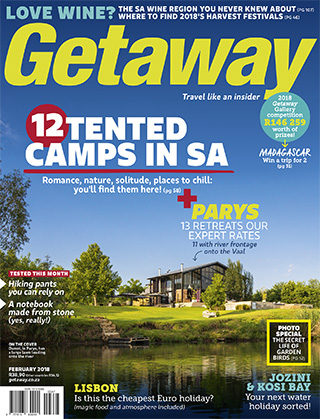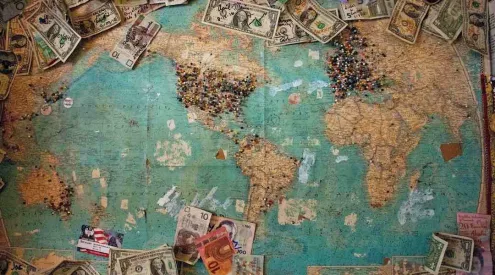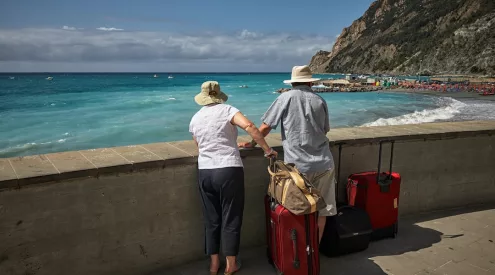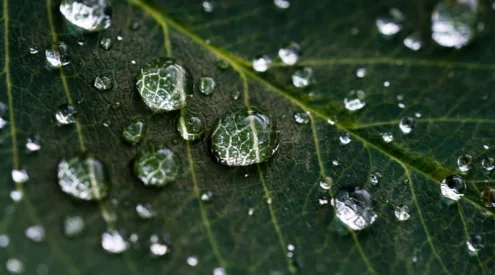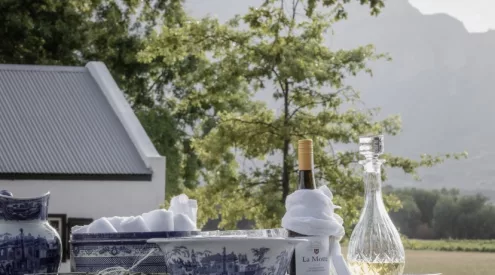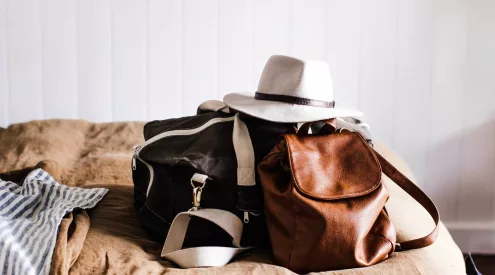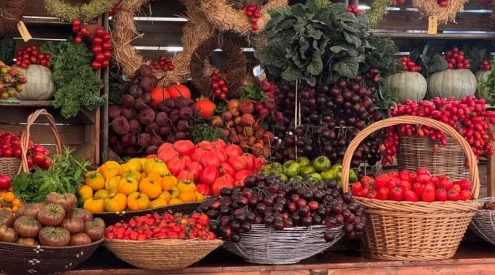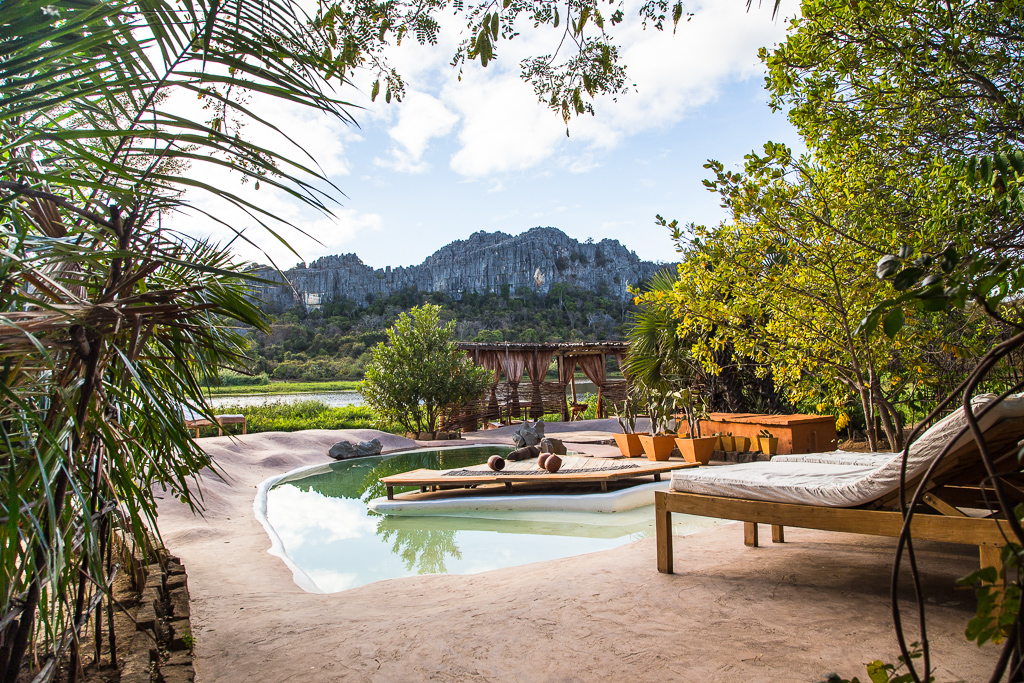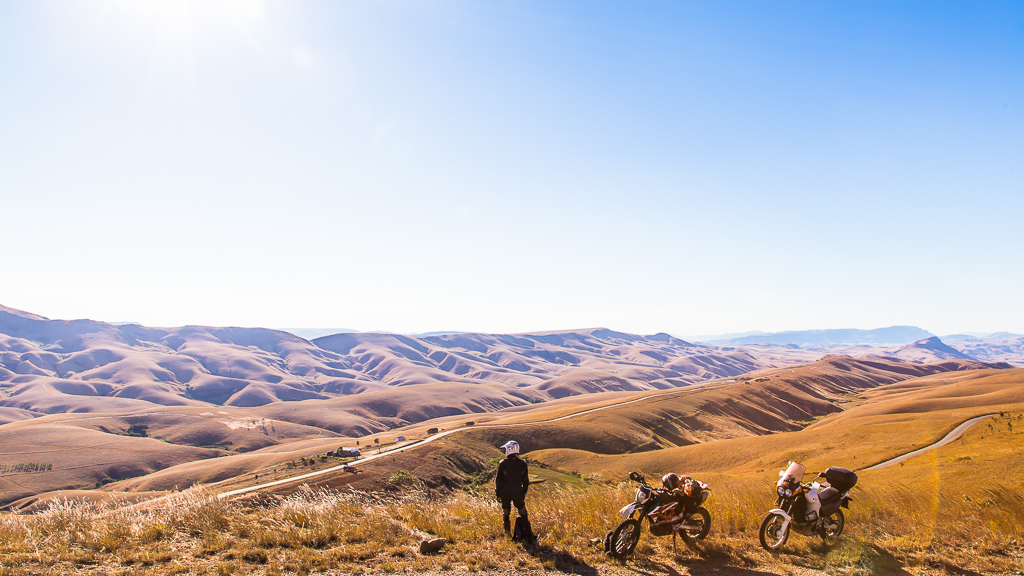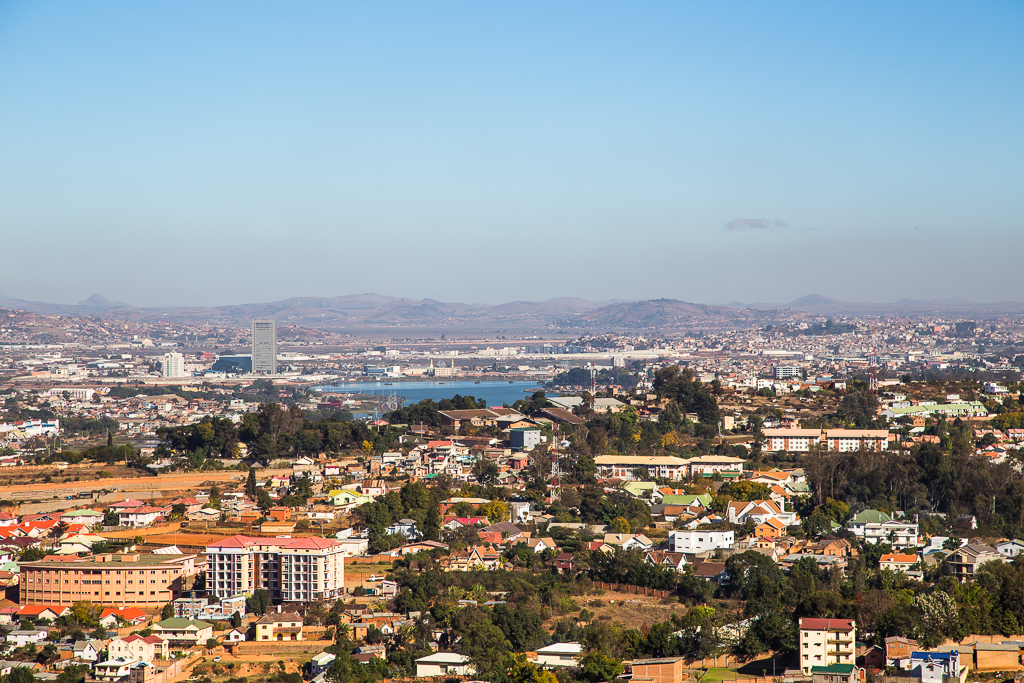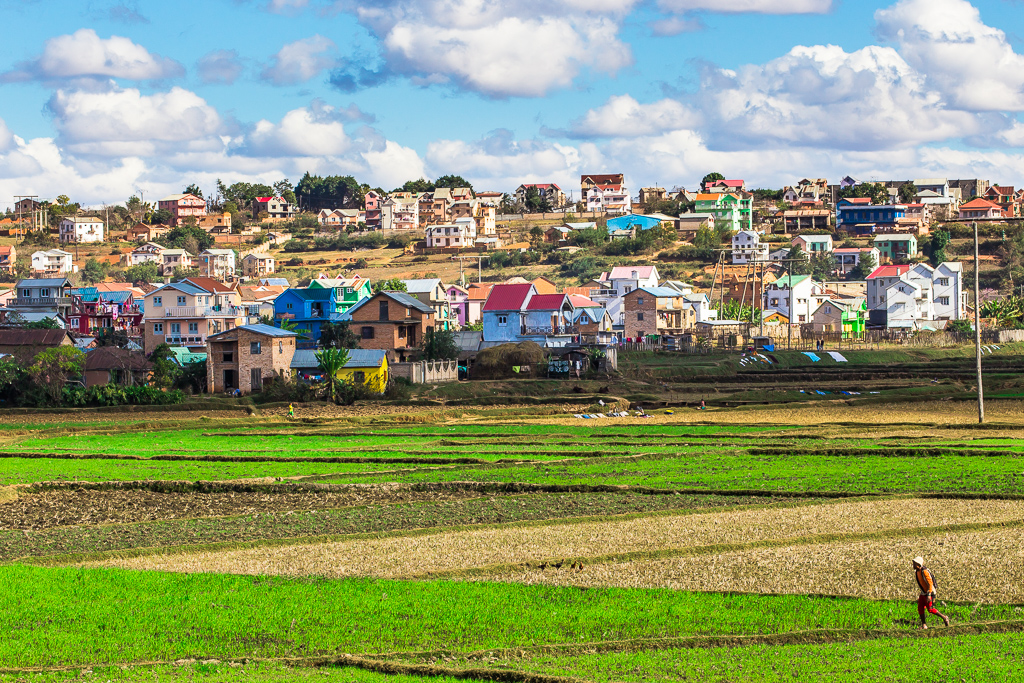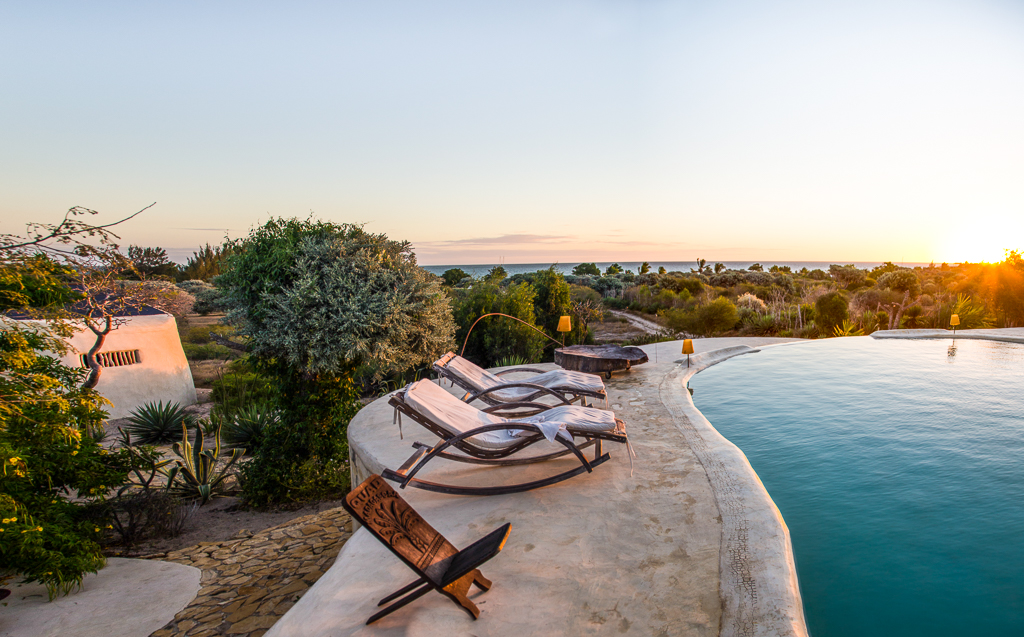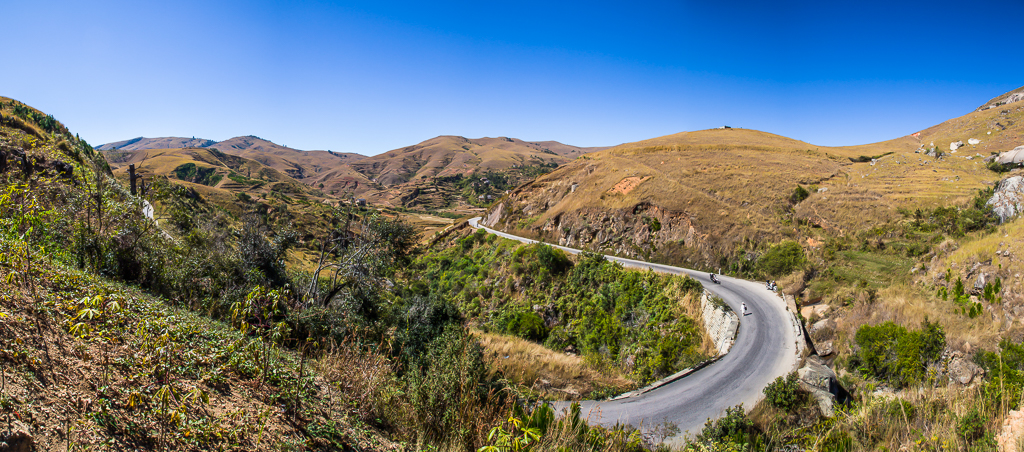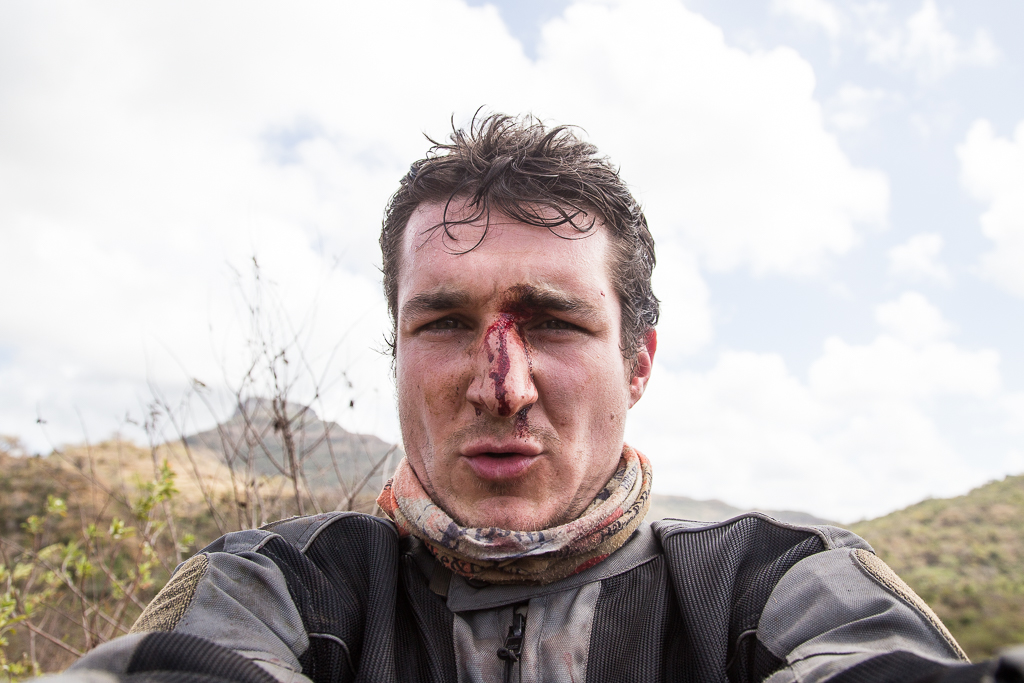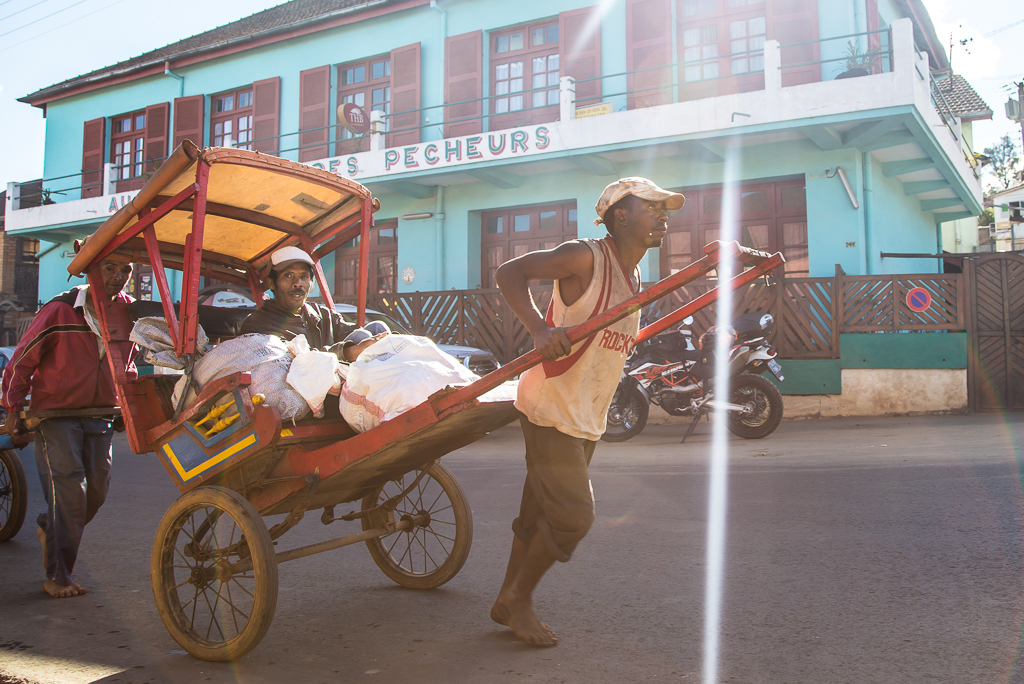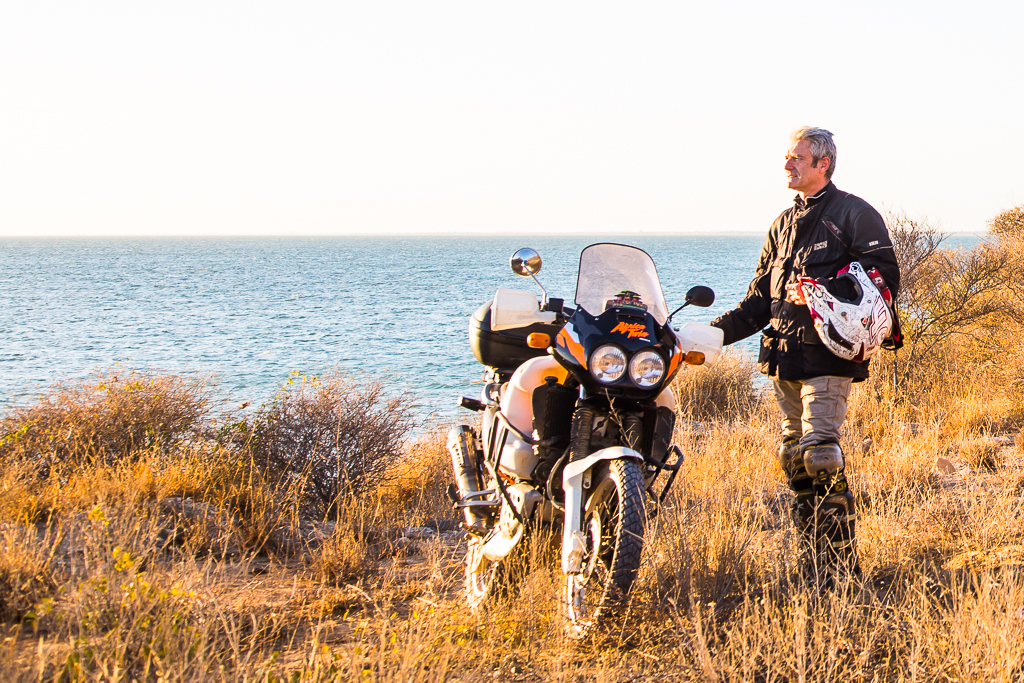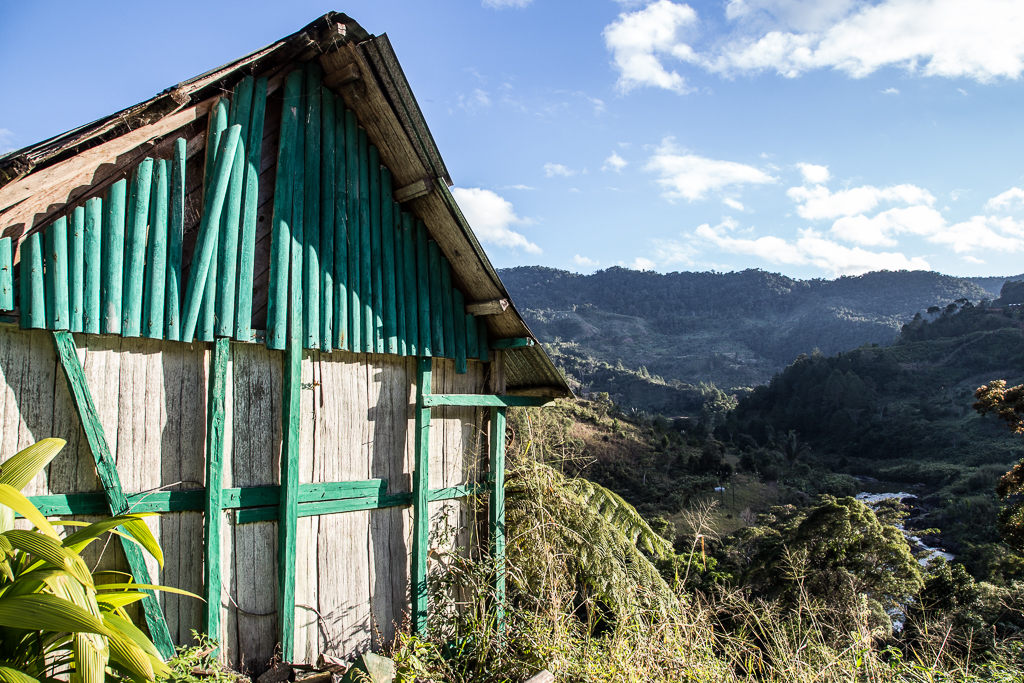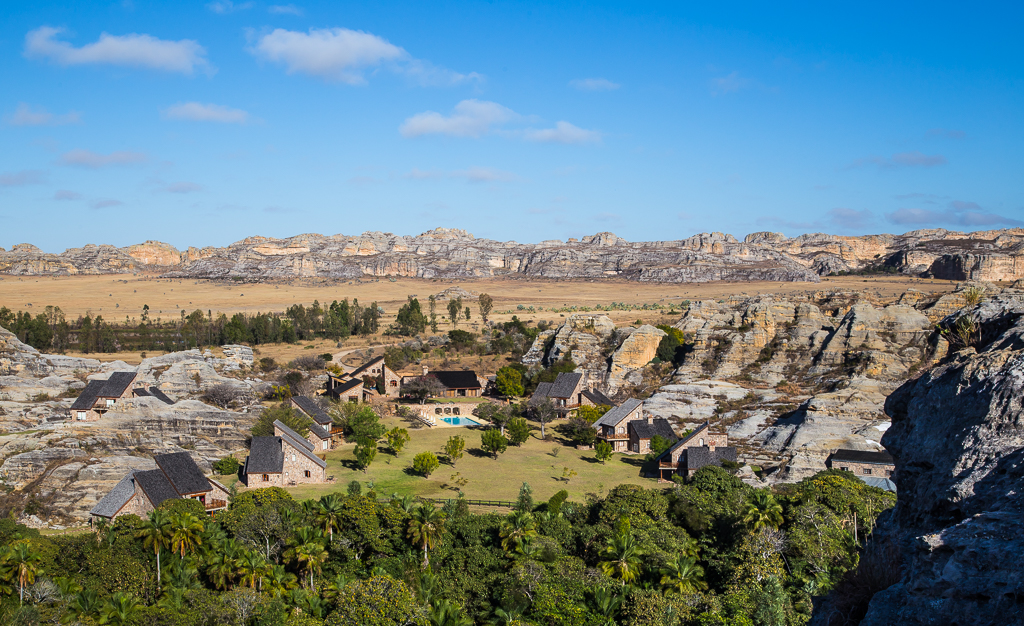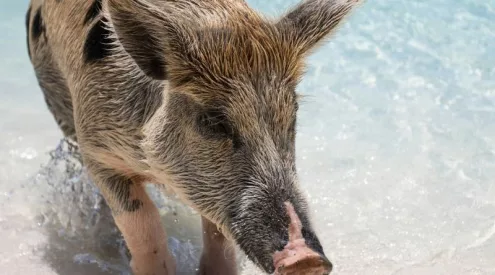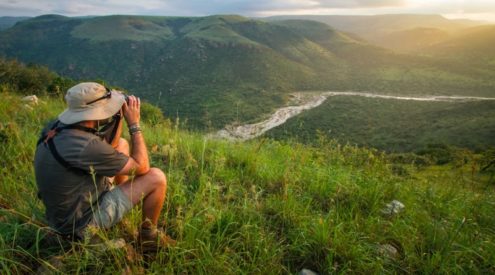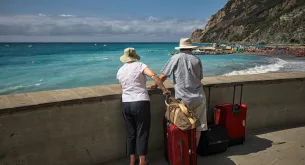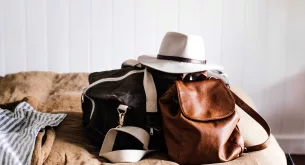Ever wanted to travel an entire country from end to end? Here’s why riding a motorcycle across Madagascar could just be the trip you never knew you needed. Words and photography by Tyson Jopson.

This is the northernmost tip of Madagascar’s mainland. To the right is the port town of Diego Suarez. It is where our adventure began. Image by Tyson Jopson
I recently learnt that there are a significant number of people who still believe the Earth is flat. That is to say, they think it is a sort of disc, a hamburger patty ringed by a wall of ice that keeps our oceans from spilling over into the infinite abyss. They argue that when we move on the surface of the planet we can see and feel that it is flat, and we must trust that. These people are idiots. They should be shot into outer space (for an education). Better yet, they should be sent to Madagascar.
There they will find a place so uneven that it curves at the edges; a living, breathing body of land with a long, arched spine of mountains running down its eastern flank. Below those they will find a rainforest with towering mega fauna – aberrant ferns emancipated from Gondwana’s supercontinental stock. They will find knotted highlands that unravel west and north until they turn into towering spires of misshapen rock.
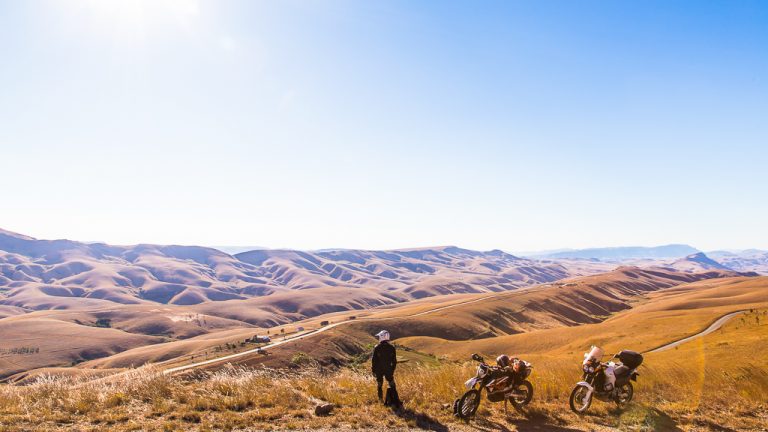
Gnarled highlands unravel as far as the eye can see. Image by Tyson Jopson
They would not be able to move without saying things like, ‘My god, Barbara. We were wrong. Nothing here is flat at all!’ Overwhelmed, they might head for the relative flatness of its northern beaches around which paradise islands such as Nosy Be float like big hunks of fish food. But even there, they’ll find giant sugar cubes that rise from the centres of abrupt bays.
And that is where I am. Astride a motorcycle on a hillock overlooking the holiday town of Diego Suarez. Half of it is beneath a bloated sheepskin sky, the other half is bathed in pastel blue and bisected by a rainbow. Inside my helmet I am wearing an eye patch, ripped from my shirt sleeve and tied around my head so as to keep a large glob of aloe over the gaping hole just beneath my eyebrow.
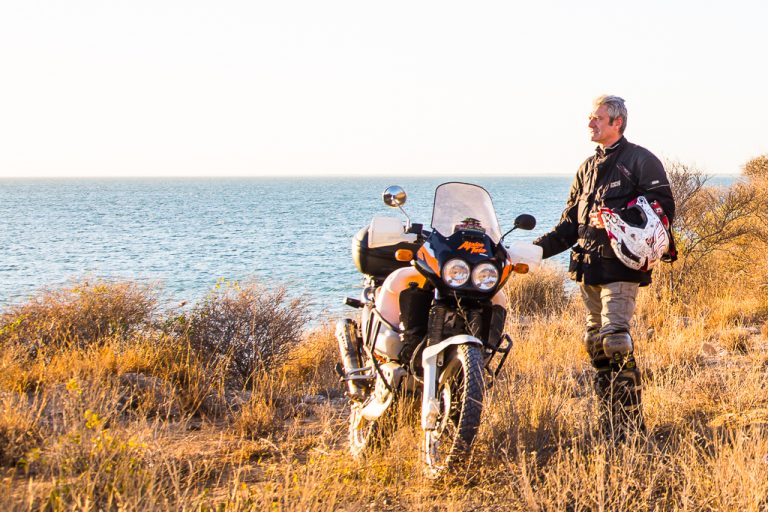
This is my riding companion, Françios Serrano, staring wistfully into the sunset. Image by Tyson Jopson
‘You can see enough to ride?’ That’s François Serrano. He runs motorcycle tours on Madagascar and knows where to find aloe in a pinch. The pinch had happened the previous day, on a shakedown ride outside of town. I was riding with my visor open and got lanced in the face by a rogue branch. Immediately, thick mulberry juice began spouting from my helmet like it was an open hydrant. Any lower and I’d have lost my eye.
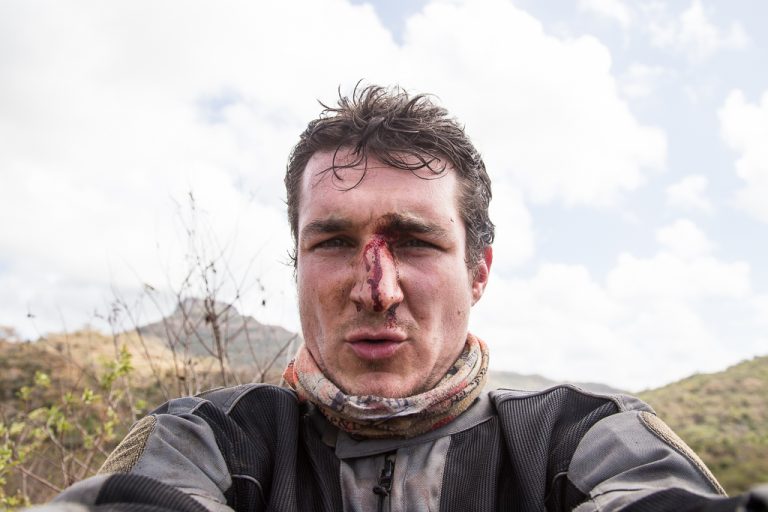
And this is me. Having just learned that riding through dense forest with your visor open is not a good idea. Image by Tyson Jopson
François is also my guide. Together we will ride the length of Madagascar – back down its curved spine, through primordial forests, windswept tsingy rock formations and canyons and past bulging baobabs to the coastal town of Toliara, more than 2000 kilometres away in the south. It is, by all accounts, the adventure of a lifetime.
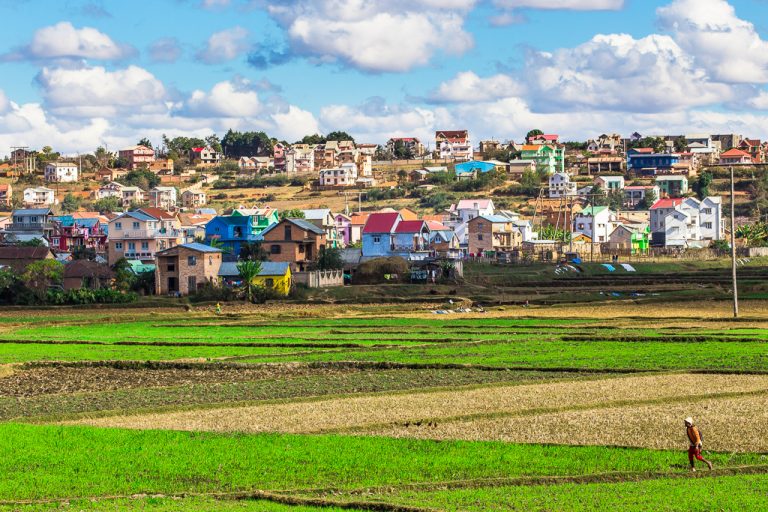
Between Madagascar’s primordial features, coloured houses and stepped rice plantations dot the the landscape. Image by Tyson Jopson
François is on an old Honda Africa Twin. I am on a brand-new KTM690. And the answer is, ‘Yes – I can see enough to ride.’ So we leave a soggy Diego Suarez behind and, over the next three days, take the road south to the capital, Antananarivo. Each day is more sublime than the last – we hike to the spiny tips of ashen tsingy in places like Ankarana Special Reserve, wind our way through chaotic ports and into highland towns that look like the sets of old spaghetti Westerns.

There’s a secret cave beneath this tsingy formation in Ankarana Special Reserve. Image by Tyson Jopson
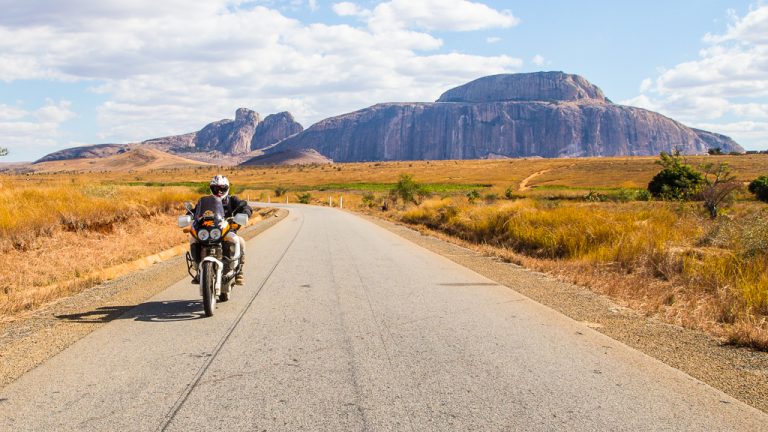
We started each day just after sunrise and rode our motorcycles deeper into ‘Wild West’ countryside. Photo by Tyson Jopson
We cross ambitious bridges, many rebuilt after being blown up at the turn of the 21st century when Madagascar found itself in the rather awkward position of having two presidents. Neither would budge and in the power struggle their acolytes blew the edifices to smithereens. We climb ever higher into the cold, remote interior; the tropical rush having long since turned into a frigid jet stream of mountain air. As we zoom on, a hole I’d ripped into my riding pants some time ago starts channelling icy air straight into my crotch. ‘I’m going to arrive in Antananarivo with the world’s smallest stalactite,’ I think. ‘If it’s even still there at all.’
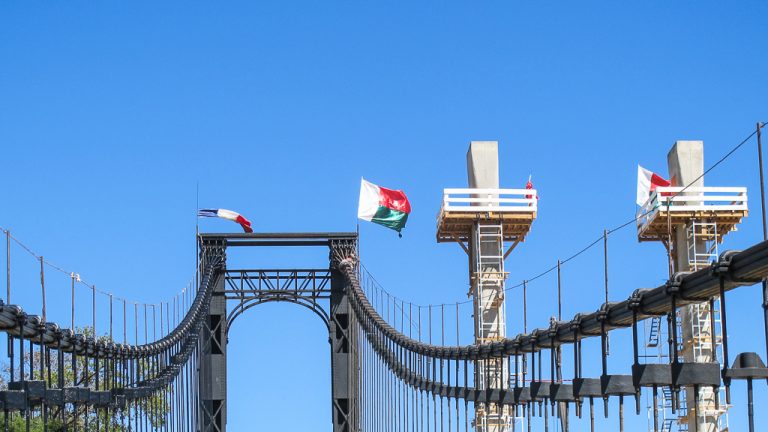
One of Madagascar’s rebuilt bridges – tall, proud, and waving the country’s flag. Image by Tyson Jopson
It’s dark when we arrive in Tana and ‘the stalactite’ quickly moves down the list of things that require my attention. It’s chaos. There are hardly any street lights, and buses, tuk-tuks and beat-up Renault 4Ls all vie for their place on the road.
There is no discernible logic to the circus of congestion, and in front of me commuters simply fall out of the backs of moving minibuses when it nears their stop. It’s like riding behind a fruit truck with the tailgate open. Except instead of landing with a splat, the bananas hit the ground running and dart for the pavement before they get mowed over. It’s wild.
But between it all is something even wilder: the two-way bike ‘lane’. There is just one rule in the bike lane – he who ducks first, loses. And so, along with busted-up bicycles and scooters swollen with baguettes, François and I play one thrilling game of chicken after another, dashing head-on into the mess until one of us gives way. It is totally mad, and enormous fun.

I managed to snap this photo of the ‘bike lane’ the next day when it was a) light and b) a lot quieter. Image by Tyson Jopson

Antananarivo in the daytime. Photo by Tyson Jopson
That night over a 3HB lager François tells me he used to travel to France every few months to compete in professional trials motorcycle competitions. He was rather good at it, I gather, and his smile creeps all the way behind his ears and his eyes twinkle when he talks about riding motorbikes. ‘Now you know my secret,’ he says. ‘Riding every day in Tana…’
On the fifth day François and I stride through the saloon doors of a marvellous wood-panelled restaurant in Ambositra. Outside, patchwork rice fields cling to the hillsides, ramshackle wooden houses rise like scruffy Jenga stacks and rickshaws loaded with fuel careen down steep cobbled alleyways.
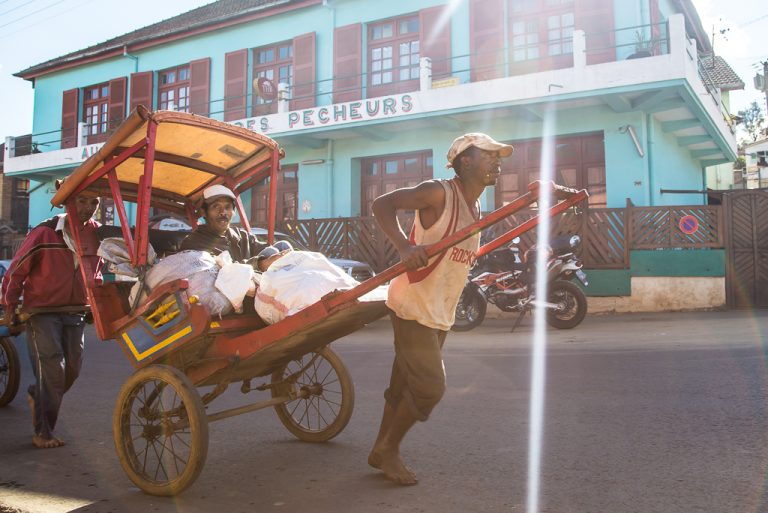
Saloon doors in the background. Cowboys in the front. Image by Tyson Jopson
Madagascar’s highland towns may look the same, but each one is something special. In Ambalavao artisans produce the most exquisite paper; Ambotalampy is the home of the metalworkers; in Ihosy we’ll smell geranium wafting from large cauldrons and further along, near Fianarantsoa, we’ll hear about a vintage railcar with rubber wheels that carted people down the escarpment from Tana to Andasibe.
But today we are in Ambostira, Madagascar’s wood-carving capital. And it is François’ birthday. In the kitchen, two chefs prepare the food by shouting at it. At least that is what it sounds like. The commotion is such that we can hardly hear each other speak. So we don’t. Instead, we share a celebratory bottle of wine in silence.
It is a difficult thing to describe– the relationships you create with someone on a motorcycle journey. You get to know them in ways nobody else does. You learn how they ride, you learn how they’ll react. Movement becomes intuitive and you start to do things in unison, with no cues at all. You must – on the road, exposed to the elements and rushing wind, words are impotent. All that matters is what’s ahead of you. And what’s beneath you, the bike – a prosthetic limb that’s as much a part of the journey as you are.
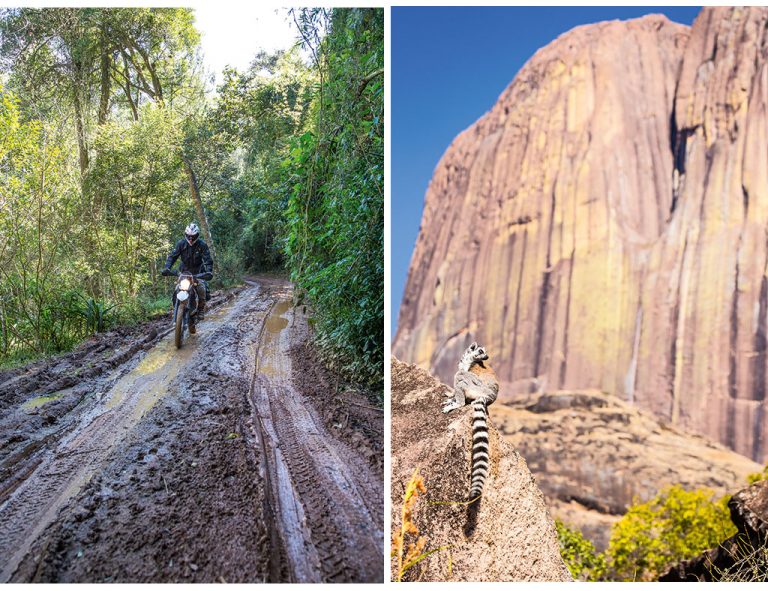
Unusual rain for this time of the year turned some of the roads into chocolate icing; this poser is a ring-tailed lemur, just one of the 105 types found on the island. Behind it is Tsaranoro. Image by Tyson Jopson
It may sound obvious but bikes are not like cars, they become a part of the adventure more than any other machine could. It takes just one ride to fall in love. Another to fall in love all over again. One more and it crawls beneath your skin and whispers, ‘Where should we go next?’ And that is why I came to ride Madagascar. And that is why François does it every single day.
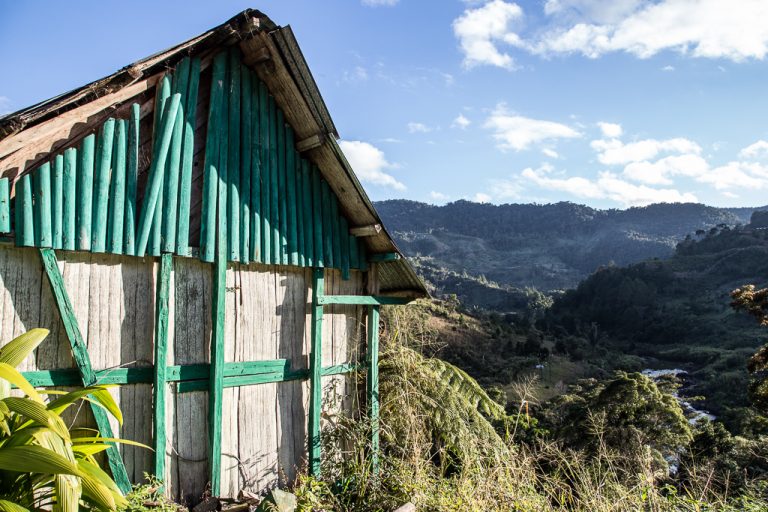
The endless green of Ranomafama. Image by Tyson Jopson
On day six we slip down the escarpment and ride into the rainforests of Ranomafana. It feels like we’re entering Jurassic Park and we stand up on our footpegs. François is ahead, his long body like a sail as he leans into the bends. The road snakes between the trees, the tar is dark and peppered with quartz glinting in the light that pierces the green canopy above. We sway left and right, collecting the shafts of light like gold coins in a computer game. It’s mesmerising. And the kind of experience that doesn’t need the passage of time to polish it into an unforgettable memory. The feeling is instant.
Here I am, exploring the world’s most spectacular island in the best way I could possibly imagine. Inside the head in my helmet The Smiths – who never seem far when I’m having a bit of a moment – start to play. And I sing along like it’s my last day on Earth.
Over the next few days we climb grand canyons and chase lemurs through overgrown forests. We meet locals, leave rooster trails on gravel roads and dangle our feet over hidden rock pools.
And then, just like that, it’s the final day and we are on the south coast. Lazy dhows wallow on crisp shores waiting for the tide to take them out. A country behind us, we both stand and stare at the ocean in silence. What a ride. And if I didn’t know it before, I’m even more certain now – you don’t need to send a satellite into orbit to know the Earth is not flat. You just need to move.
Plan your trip
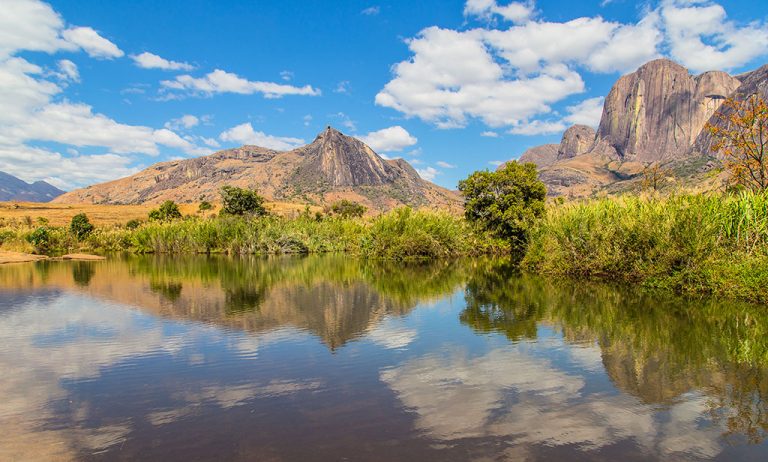
Getting there
I flew with SA Airlink from Johannesburg to Antananarivo. Return flights are from R10500.
When to go
Avoid cyclone season (February and March). The best riding weather is when it’s a little cooler and dry so I recommend the winter months (June to August).
Need to know
South Africans can get a visa on arrival for about R400. There are working ATMs in some major centres but card facilities are rare. Carry ariary (the local currency). The best way is to change your rands into Euros before you fly and then change it into ariary in Antananarivo. You’ll get fleeced if you try to change rands in Madagascar.
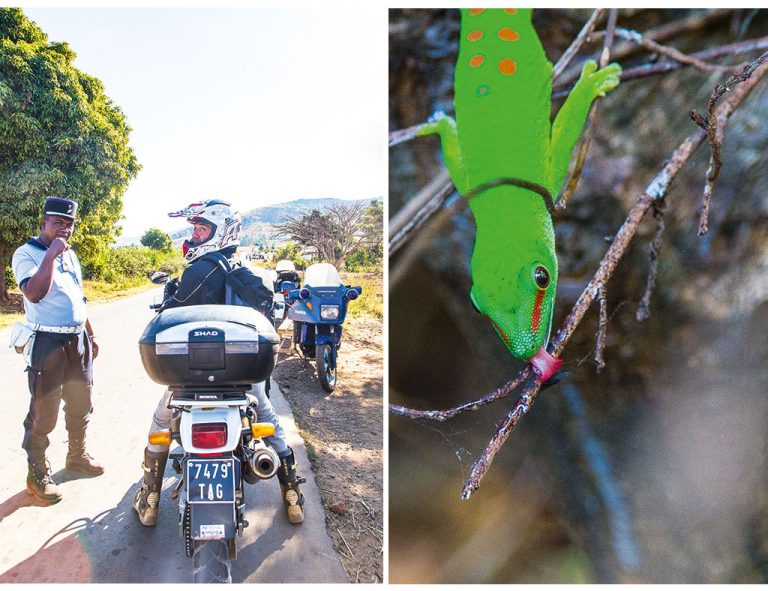
The policeman was more interested in our bikes than any potential traffic offences; this gecko has no eyelids. It cleans its eyeballs with its tongue. Image by Tyson Jopson
Moto tour Madagascar
There are a number of motorcycle tour packages available, ranging from easy road-based trips with some offroad (such as the one I did) to challenging enduro trails. Tours are best booked through Boogie Events, who can put together an itinerary in English and recommend the best bike in Moto Tours Madagascar’s fleet (includes KTM 350 EXCF, 690 Enduro, 390 Duke as well as larger adventure bikes for longer trips) to suit the type of riding you’d like to do. Custom tours are available too (you choose the type of terrain, accommodation, extra activities and number of days). From R25 000 per person for a seven- day tour, including motorcycle hire, board and lodging.
Stay here
These were the best overnight stops on my eight-day trip: Iharana Bush Camp in the Ankarana Special Reserve is a breathtaking eco-lodge on the banks of a large lake. There’s a swimming pool (great for a dip after a long ride), hiking trails, even a day spa. From R1500 per person.
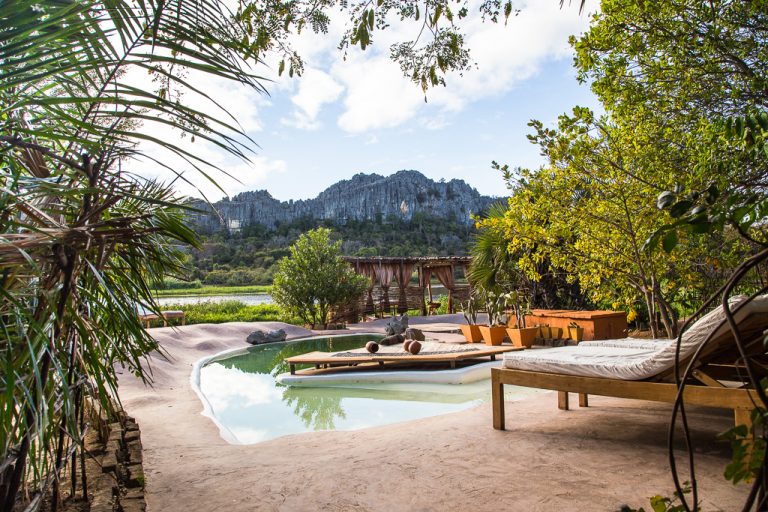
Iharana Bush Camp. Image by Tyson Jopson
NY Tranovola in Antananarivo recently opened its doors and, despite the face brick facade, is rather cosy inside. From R450 per person B&B. Find it on Facebook.
Chez Gaspard is just outside the Ranomafana National Park and the perfect base from which to explore it (park entrance, including a guide and community tax, is R550, parcs-madagascar.com). Rooms are comfortable and clean and the gardens are magnificent. From R250 per person. +261328711515
Tsara Camp is a collection of luxury safari tents in the shadow of the world-famous Tsaranoro rock formation. Here you can hike, climb, go looking for lemurs or just relax. It truly is a special place. From R980 per person.
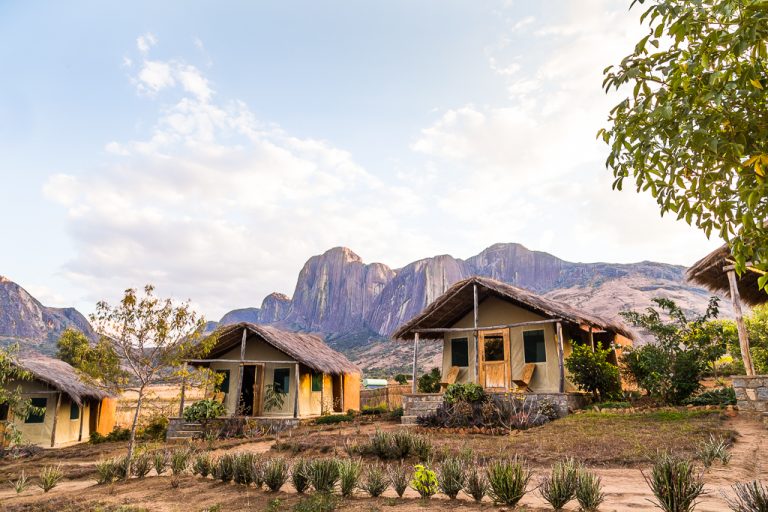
Tsara Camp. Image by Tyson Jopson
Hôtel Le Jardin du Roy could well be the grandest lodge in Madagascar. The grounds are sprawling, the rooms meticulously set out and the food as fine as it gets. It’s also a playground for adventurers (hiking, via ferrata and horse riding). From R1500 per person.
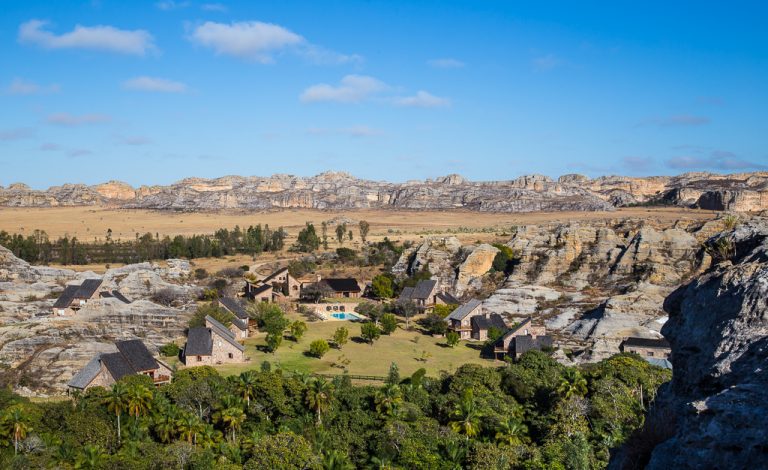
Hotel Le Jardin du Roy. Image by Tyson Jopson
Bakuba overlooks St Augustin Bay outside Toliara. A mix of Gaudíesque curves and French hospitality make this a really unique stay. Rooms are rustic chic, meals are of the gourmet variety and my favourite was waking up to sunrise over the bay. From R900 per person sharing.
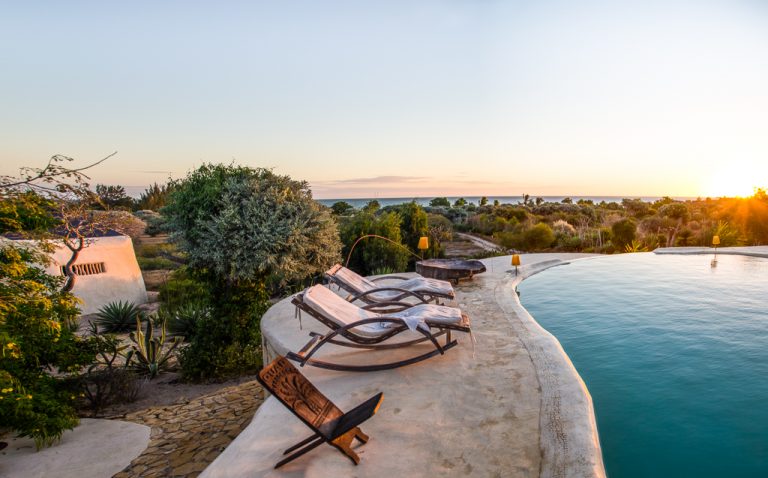
Bakuba. Image by Tyson Jopson
This story first appeared in the February issue of Getaway magazine.
Our February issue features 12 of the best tented-camps around the country, fun-filled water adventures in Northern KZN, Madagascar by motorbike plus a guide to finding everyday magic in underrated Lisbon.
